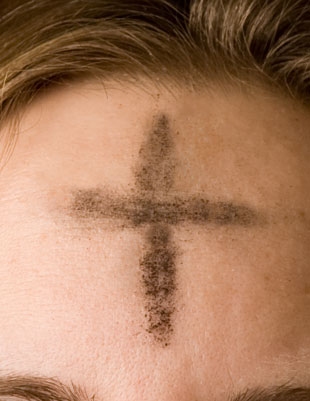Over the years, Catholic priest and prolific devotional writer Edward Hays has given us books filled with creative practices to be used during the 40 days of Lent: A Lenten Hobo Honeymoon, The Lenten Pharmacy, and The Lenten Labyrinth. In the latter, he writes of Ash Wednesday and suggests a simple practice to keep its meaning with you through Lent:
"Today your home should be decorated in Halloween fashion as you stand at the gateway to the great Lenten labyrinth. Before swinging open the iron gate of the labyrinth, ponder these lines of Edna St. Vincent Millay's poem, 'Dirge without Music.'
"Down, down, down into the darkness of the grave
Gently they go, the beautiful, the tender, the kind;
Quietly they go, the intelligent, the witty, the brave.
I know. But I do not approve. And I am not resigned."
"Among all the animals, humans are the only ones we know of who can ponder their own death. Yet while all humans can, few do. We prefer to be like our cats or dogs and think only of today or our next meal.
"Ash Wednesday challenges us to ponder the reality we most dread to consider: our own death. The journey of the labyrinth and the way of the disciple of Christ begins with the task of seriously reflecting on one's own death, embracing it so that one can truly embrace life.
"May the gift of holy ashes placed on your forehead on this ancient holy day (or a plastic packet of dust or earth you prepare*) help you realize that only by a Christ-like death can you experience the promise of Easter's life.
"*Some dust of the earth in a small plastic bag can be a useful Lenten aid. Place it in your prayer corner or on your desk as a daily reminder of death. It will help you treat each of these forty days as significant."
"Lent was originally a penitential season of reconciliation with the church — ashes and sackcloth being the visible signs of repentant sinners who were seeking public reunion with the church. Along with fasting, ashes were a sign of mourning and grief at times of death. In times of disaster, they served as physical offerings of supplication to God. Christian ascetics used to sprinkle ashes on their food to indicate their total disdain for the pleasures of the body. The ancient Mayans of Central American used ashes as an inoculation against disease, much like a flu shot. When planting corn, they mixed in ashes to protect their seeds from blight and rotting.
"Now, you are not a sinner seeking public reconciliation and quite likely you are not planting corn or mourning the death of a loved one, so how can today's ashes be good medicine for you? You can start by letting today's ashes vaccinate your seeds of reform against maggot 'tomorrowitis,' that procrastination fungus that postpones a return of life until next year's Lent or even until your deathbed. The pharmacist-healer Jesus says to all those suffering from lethargic encephalitis, the deadening inflammation of the brain that is so common in our culture: 'Stay awake. Seek healing this very day, for you do not know if you will be alive tomorrow. Now is the hour to awaken.'
"Because of infirmity, family obligations, or work-related responsibilities, you may not be able to go to church today and be marked with ashes. But do not let that prevent you from being touched by this powerful ancient medicine. All the earth is holy land and its soil is blessed. So, place a small pinch of dust or dirt in the palm of your hand and use it to trace upon yourself the sign of the cross, a sign of death that leads to new life, as you prayerfully ask God to heal you."
